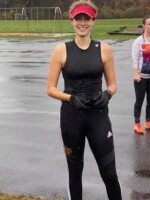Jim Pistrang, Amherst MA September 2020
In the fall of 2020 I ran a Socially Distant Middle School Ultimate Skills Clinic in the town of Amherst for kids in grades 5 through 8. The Clinic was designed to keep players at least 10′ distant from each other at all times. The clinic met 2x/week in 2 hour sessions, and the maximum number of participants was set to 30. I had 5 responsible & experienced high school players working as assistant coaches. Here are the details….
Comments? New drill or game suggestions? Send me an email!
Supplies
- Hand Sanitizer
- Extra water (in plastic bottles)
- Extra masks
- 30 discs
- 30 cones
- med kit & ice packs
Field Setup
The field was set up in a painted grid of six parallel lines, each 150′ in length. There were painted hash mark every 10′ along each of the lines.
On one side of the field there were 30 painted ‘home circles’ in two long rows. The circles were even with the hash marks, so the centers of the circles are 10′ apart from each other. There were painted numbers inside each circle, from 1 to 30.
Arrival & Departure Protocol
On the first day each player was assigned a Home Circle and told to return to the same (numbered) circle for future sessions. Players were asked to stay masked when arriving in the parking lot and going to their circle, and asked to be masked at the end of the session when going from the circle back to the parking lot. During the session the players did not need to wear masks (but some did anyway). Players were told to bring water, hand sanitizer, and appropriate clothing. We gave water bottles to anyone who forgot water.
Session Agenda
Our typical agenda looked like this:
- Notes & Attendance
- Warmups
- Jog
- Drill #1
- Drill #2
- Water Break (in their Home Circle)
- Drill #3
- Game
- Sprints
We often repeat drills, but we tried to introduce one new drill every session (or at least every week).
Warmups
The kids are spread out on the hash marks on lines #1 and #6, with one or more coaches in the middle leading warmups. Each line of kids moves towards the center a distance of 2 lines in and back, covering 30′ in each direction. When both lines of kids are in the center (on lines #3 and #4 they are still 15′ apart from each other.
Jog
One or more coaches leads the jog, going at a slow pace (these are middle school kids). Players are instructed to stay at least 10′ behind each other and never pass the person in front of them. At the end of the jog the players return to their home circles to await instructions.
Drills
Here are descriptions and images for all of the drills that we used. The drills were always taught and executed in the context of the Ultimate skills that they are enforcing. For example, the cutting drills emphasize hard cuts, hard changes of direction, running at full speed until the disc is caught, etc. Coaches either participate or observe, giving frequent reminders and encouragement to the players.
Throwing In Pairs Drill
Players line up facing each other on two lines, either 30′ apart or 45′ apart. Players throw back & forth, coach instructs on the type of throw – flat backhand, outside-in forehand, etc. Coaches can pull out individual players for one-on-one instruction. One line ‘rotates’ every few minutes so kids aren’t always with the same partner.
Skills: Throwing; Catching.
see the throwing in pairs drill
Coach Cutting Drill
Divide players into groups, each group with a coach. Around 8 players with a coach is ideal, but can be adjusted based on your numbers. Players are in a line. Coach (with a pile of discs) is located 30′ or 40′ feet from the front of the line.
- Coach calls ‘CUT’
- The front player makes a hard out-in cut
- Coach throws to player as they are making the IN cut.
- Player keeps running on ‘clearout path’ after catch
- Player drops disc behind coach and continues running to the back of the line.
- Players in the line move up after each cut.
Skills: Cutting; Catching while cutting.
Player Cutting Drill
Same as the Coach Cutting Drill (above) but players take turns being the thrower. One option is to have the next player in line to be the thrower stand behind the thrower at the disc pile and ‘feed’ discs to the thrower.
Skills: Throwing; Cutting; Catching while cutting.
Go To Drill
Players line up in two lines opposite each other. One disc is used in this drill. The drill begins with one player in the ‘catch location’ with the disc. Player in the opposite line makes an out-in cut. Player with the disc throws to the cutter and clears out immediately after their throw to the back of the opposite line. Receiver throws to the next cut, clears out, etc. Timing and awareness are important in this drill – the IN portion of the cut should begin when the thrower has possession and is set to throw. If a disc is dropped, cutter should reset and begin the cut when the thrower has possession.
Skills: Throwing; Cutting; Timing of cut; Catching while cutting.
Rouisse Drill
This cutting drill uses multiple discs, one per player in the drill (minus 1). The first cutter makes a cut to one side – either a straight 45˚ cut or an out-in cut. The first thrower throws to the cutter and immediately makes a cut to the opposite side. After the cutter catches the disc they run with it to the back of the opposite line.
Skills: Throwing; Throwing ahead of the cutter; Cutting immediately after a throw; Cutting; Catching while cutting.
Cutting Sequence Drill
The cutting sequence drill incorporates multiple discs and multiple players (minimum of 16). There are 4 lines – throwing line, cutting line 1, cutting line 2, and cutting line 3. The drill involves a series of out-in cuts, where players move from one line to the next after throwing.
Skills: Throwing; Timing of cut; Cutting; Catching while cutting.
In-Cut Sequence Drill
The In-Cut Sequence drill works with groups up to 6 players.
To start, P1 (initial thrower) yells ‘go’, P2 sprints to cone then cuts back in an IN cut to receive the throw. Remaining players jog, keeping the sprinting player in front of them. As P2 cuts back in, P3 switches from jog to sprint, cuts back in at their cone, etc. The image shows two sets of cones, which allows for a simple rotation before coming back in the other direction. In our clinic with 3 or 4 groups, we have all groups go from left to right, then they all rotate and go back from right to left.
Skills: Throwing; Timing of cut; Cutting; Catching while cutting.
Leading Pass Drill
The leading pass drill incorporates multiple discs and multiple players (minimum of 12). There are 2 cutting lines and a single thrower. A cutter at the front of the cutting line cuts towards the sideline and then hard across the middle of the field. The thrower throws a leading pass – the cutter should not have to slow down, and should catch the disc near the center of the field. The thrower should throw from the correct side of the body depending on the direction of the cut. Cuts alternate between the two cutting lines. A new thrower comes in after around 15 throws.
Skills: Throwing leading passes; Throwing from correct side of body, Hard cutting; Catching while cutting.
Dump Swing Drill
The setup is a handler, a dump, a swing, and a cutting line. Handler faces forward with disc. After a few fakes the handler turns their body and passes to the dump. The dump immediately passes to the swing. The cutter makes an out-in cut and receives a pass from the swing. The cutter then carries the disc to the disc pile (next to the handler) and returns to the back of the cutting line. Rotate after ~15 throws: handler to dump, dump to swing, swing to cutting line, cutter to handler. Continue until all players have had a chance at hander, dump and swing positions.
Skills: Faking; Throwing; Short passes; Quick catch & throw; Timing of cut; Cutting; Catching while cutting.
Triangle of Death Drill
Single thrower with two cutting lines. Thrower runs FAST in a triangle between the two throwing positions. Coach throws to the thrower when they reach a throwing position, thrower then throws to a cutter running deep. If thrower fakes, cutter cuts in. Thrower runs immediately after throw to the new throwing position.
Skills: Throwing; Throwing under pressure; Cutting; Catching while cutting.
Fake and D Drill
The drill is run in groups of 4 players – with 5 players in a group you can have one sitting out and coming in on the next rotation. The Thrower and the two Receivers must stay in a fixed location and maintain a pivot foot. The Defense player can move laterally. The thrower has 10 tries to get a complete pass to either receiver, using fakes to move the defense and get them off-balance. The defense can do a stall count of 5 seconds (start the stall count at 5). The throw can not go over the reach of the defense – i.e. you can not just throw short hammers. Slight adjustments to the placement of the Receivers make the drill easier or harder – moving the two Receivers just a few feet closer together will make it harder to complete a pass. Rotate after 10 throws: Thrower => R1, R1 => R2, R2 => Defense, Defense => Thrower. You can make a game by counting points for the Thrower and Defense: a point for the Thrower on a complete pass, a point for Defense on an incomplete pass. This is not exactly fair – a good pass that is dropped will be a point for defense – but it is the best I came up with!
Skills: Throwing; Faking; Defense.
Games & Contests
Here are descriptions and images for all of the games and contests that we used:
Sovereign Of The Hill
Line up in the same format as throwing in pairs. Rotate a line if necessary to avoid having partners who are the two strongest players. All players throw back and forth following the instructions of the coach. Instructions might be ‘any kind of throw’, ‘forehand only’, ‘hammer only’, ‘one-handed catch only’, etc. If a throw is incomplete for any reason, the two players grab their disc and go around the outside of the lines to the back of the lines. Players behind them (when the drop occurred) move up in the line. The winners are the two players who are at the front of the line when the timer goes off (I usually do 3 minutes or 5 minutes). To make it more interesting – declare the top two positions the Red Zone. Players in the red zone would have more difficult rules, such as ‘throw with your off hand’, ‘hammers only’, ‘hammers with one-handed catches’, etc.
Go To Contest
Line up in two (or three or four) side-by-side go-to drills. There are a few options on how to run the contest:
- As soon as there is a drop the entire ‘team’ sits, and counts the number of consecutive passes that the other team completes from that point forward. Losing team does pushups/situps/whatever for that number.
- Use a stopwatch with a fixed time count (5 minutes is good). Whichever team gets the most complete passes before time is up wins. This option has the advantage of encouraging the kids to make fast cuts and throws.
Accuracy Relay
This is a relay race (of sorts) in which teams compete to see which team will be the first to reach 5 (or 10) ‘knock-downs’ or to see which team gets the most knock-downs in a fixed period of time. Players make a hard out-in cut, a coach throws to them, and they receive the disc near the throwing line. After their catch (or miss) they run with the disc to the throwing line and try to knock over the cone. After their throw at the cone they clear out to the back of the line. If they throw from on or over the throwing line it is a foot-fault and the knock-down doesn’t count. As with the Go To game, a fixed amount of time (as opposed to a total to be reached) encourages faster cutting and speeds up the game.
October 16, 2020 Note: We stuck ‘driveway marker’ poles into the ground and put the cones on top of the poles. Team gets one point if hitting the pole causes the cone to fall, 2 points if they actually hit the cone and it falls, zero points if they hit pole or cone but the cone does not fall. This was a little more exciting than a cone on the ground, and it encouraged chest-high throws instead of throwing at the ground. Thanks to the Maplewood NJ coaches for this idea.
Disc Golf (socially distant)
Disc Golf requires a disc for each player. We use Ultimate discs, since we are practicing Ultimate skills. Set up a number of ‘holes’ in your playing area – might be a fence post, a soccer goal, a cone that gets knocked over, etc. Divide your players into small groups (maximum of 6 per group), give each player a disc, and have each group start on a different hole. Players should not be throwing close to their next hole until the group in front of them has moved on. Players keep track of their scores (honor system) and the lowest score wins. Players in a group must stay 10′ apart from each other. It is helpful to have a coach in each small group if possible.
Ultimate Foosball
This game can include anywhere from 12 to 30 players – possibly more if the field can accomodate. You will also need two goals – small soccer goals or lacrosse goals or anything else you can come up with. You could also possibly use two cones and an in-person goalie instead of goals, but I haven’t tried this. The images (below) display the range of players on the red and green teams. A player can move laterally in their range, but cannot move out of their range in any direction. Start the game with the disc in the hands of a player on the ‘back’ line. Players can pass to any other player on their team. There can not be more than three passes in a row on the same line. Stall counts can be called by the player opposite the player holding the disc. The player in possession of the disc must maintain a pivot foot. On a turn the defense immediately becomes the offense. On an incomplete pass the disc goes to the nearest player. A point is scored when the disc enters the goal in the air. Players on both teams should rotate in opposite directions to give everyone a chance at all locations. inspired by an idea from Lynne Nolan
Note: The revised version shortens the player ranges and the distance between ranges, sets stall count at 5 instead of 10, and includes a rotation plan. This version is working better for the middle school kids.
Skills: Throwing; Throwing under pressure; Defense; Stall count; Cutting (laterally); Catching while cutting.
see the game (18 players, revised)
Sprints
Sprints were run at the end of each session. Half of the players stand at hash marks on the first line while the other half wait in their home circle. Each sprint is across the field from line #1 to line #6 and back again which is a total of 150′. The kids run in groupings called out by a coach, such as ‘all 8th graders’ or ‘all kids wearing blue’. It ends up with each kid running around 6 sprints, then they sit in their home circles and the other half go up to the line.
Pictures
Our wonderful coaches……







